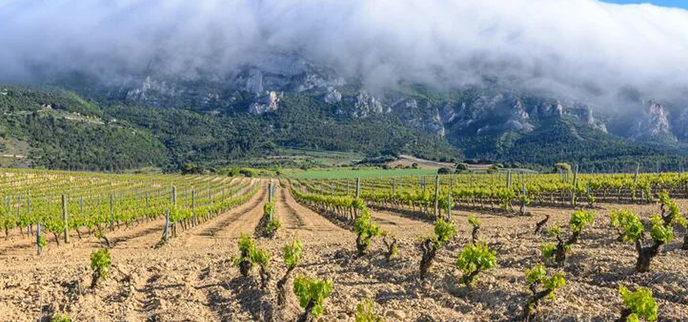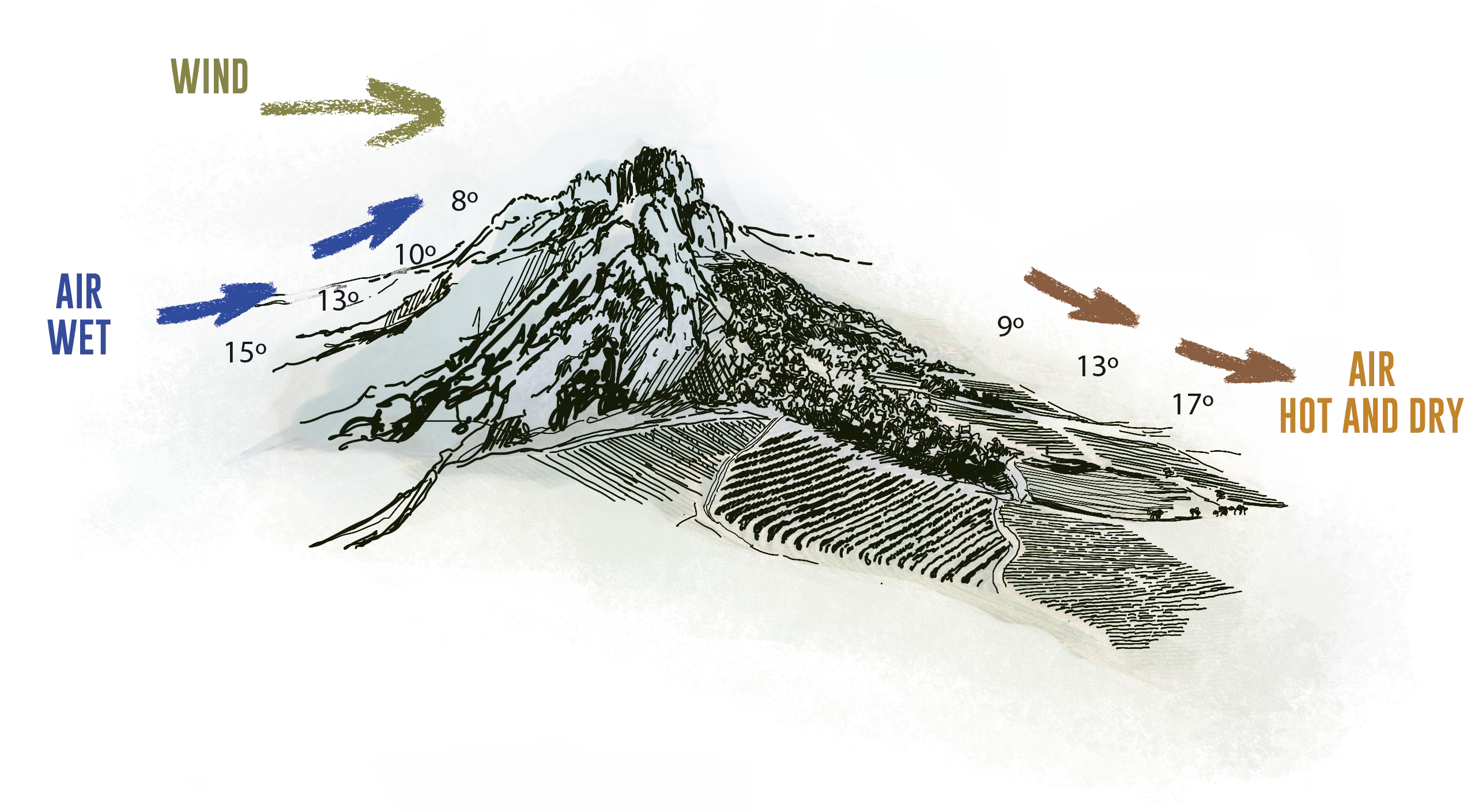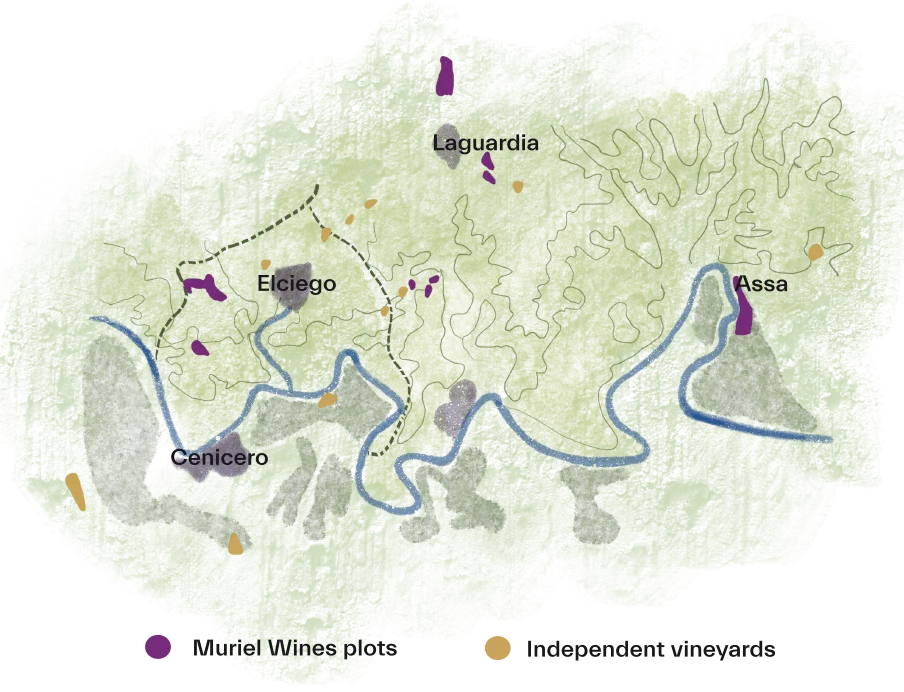
MURIEL WINES IN RIOJA ALAVESA
VERIQUETE · EL GALLO · GARCIMORACHO · ASSA · REÑANA · RIHONDILLO · HOYO DEL PINTOR
In general terms, the grape production area nestles in a valley bounded by two large mountain ranges, the Sierra de Cantabria and the Sistema Ibérico, forming a space with great geographical diversity:
Rioja Alavesa: nestling in the foothills of Sierra de Cantabria with its lowest parts bordering the River Ebro. The vines are planted in small vineyards on terraces and hillsides.
Rioja Alavesa is one of the main subregions of the Rioja PDO. It is situated in the northwest of the Rioja area in the province of Alava. Its physical geography could be defined as sloping terrain that ascends from its lowest point on the banks of the River Ebro (400 metres), climbing quickly, in just 10 km, to the 1400 metres altitude of the Sierra de Cantabría. This is why it has such rugged geography, made up of the numerous hills, terraces and mountains that characterize its landscape.
The vineyards extend from the banks of the Ebro (350 metres above sea level) to the foothills of the Sierra de Cantabría (650 metres). Due to the steepness of the terrain, the vines are planted on small fields on terraces and banks with an average size of no more than half a hectare, a very distinctive feature of this area. The greater the variability in the vineyards, the greater the variability and diversity in the grapes and wines obtained from them.
It has a temperate Mediterranean climate with both Atlantic and Continental influences.
Its proximity to the mountains means that there are notable Atlantic influences. The presence of the mountains is crucial in that they act as a barrier to the wind and rain from the Atlantic. The mountains are an integral part of this area without which it would not be what it is.
The soils of the Rioja Alavesa were formed on top of sediments from the Tertiary Era made up of limestones, marls and sandstones. The most important original soil in this area is known as “Tierra Parda Caliza”, a poor, yellowish-brown soil that is strongly calcareous and more or less stony. 90% of the Rioja Alavesa has this kind of soil, the only exception being the alluvial soils on the banks of the Ebro. In short, these are soils that leave a very specific mark on the wines produced.

MURIEL BLANCO
This wine stands out due to the structure and expression of the Viura grapes, together with the sweet touch of the White Tempranillo. Added to this is the sticky sweetness and the body provided by blending with aged wine.

MURIEL CRIANZA RIOJA ALAVESA
Aromatic freshness, concentration and finesse on the palate are the characteristic features of a wine that expresses the essence of Rioja Alavesa

MURIEL RESERVA VINO DE ELCIEGO
The complexity resulting from the fusion of all the types of soil in Elciego and their different contributions makes this wine appear well-structured and expressive.
FOEHN EFFECT

It takes its name from a wind on the north side of the Alps and occurs when a mass of air is forced upwards when it encounters a mountain.
This makes it cool down and causes the water vapour it contains to condense, so producing precipitation on the ascendant side. When later it descends on the other side of the mountain, the air mass has lost its moisture. The dry air drops quickly, increasing the atmospheric pressure and therefore the temperature. In this way, the moisture and rain on the windward side become clear skies and heat on the leeward.

This effect is easy to observe in the Rioja Alavesa and the northern areas of La Rioja Alta. These areas are bounded by the Sierra de Cantabria, a geographic barrier that produces this effect, which is a determining factor in the microclimate. It is important to realize that if this effect did not exist, the vines would not develop properly as the humidity and temperature conditions would be very different from those prevailing today.
ELCIEGO

Elciego is one of the areas of Rioja Alavesa and of Rioja with the greatest density of vineyards.
Given its geographic situation and the variability of its terroirs, it could be considered a mini-Rioja Alavesa in that it has all the different soils and aspects found in the subregion as a whole.
Due to this variability, Elciego wines are typically very elegant, complex and balanced. They are regarded as wines with great aging potential.
Tempranillo is the dominant grape variety in Elciego and the oldest vineyards have Viura vines mixed with Tempranillo. Elciego could be viewed as one of the “golden miles” of Tempranillo in La Rioja.
One factor that makes the Elciego area special is the high variability and diversity of its grape production areas. These include all the different kinds of terroir to be found in Rioja Alavesa:
- High area: highest part of the municipal area (520 metres). It is situated on quite a flat plateau. It has very moist, deep brown, calcareous-clayey soils, which lead to very elegant, complex wines in which the fruit is always present. Our iconic El Gallo estate is situated in this area.
- Middle area: With an average altitude of 450 metres, this is the most common terroir in the Elciego area. It is made up of small vineyards on terraces and hillsides with different aspects. It has the classic, characteristic, very poor, white limestone soils with a clay-calcareous texture. Our Garcimoracho and Hoyo del Pintor estates are in this area.
- Low area: This is the area on the banks of the river Ebro with an average altitude of 350 metres. It has alluvial soils with a predominantly sandy texture. This is where the grapes ripen earliest, giving rise to very aromatic wines with a medium structure.
Therefore, the combination of such diverse areas means that Elciego wine as a whole has a very characteristic profile combining freshness, elegance and complexity.

- 480 ha. of controlled vineyards between the villages of Baños de Ebro and Lanciego.
- 83 ha. of old vines 10 Ha that date from 1920 and 32 Ha pre-1950).
- 450 ha. planted with Tempranillo vines.
- 30 ha. planted with Viura vines.
In the Rioja PDO area, a vineyard is legally defined as old if it was planted before 1980. The most important feature of old vines is that they are perfectly adapted to the conditions of the local area (soil and climate). This enables the vines to reach the right balance in terms of their growth and output.
The old vines typically produce less grapes. These grapes have a much higher concentration of colour and tannins as they are normally smaller in size.
Similarly, in the wines made with old vines, it is possible to detect the “minerality”. This concept refers to the perception at an organoleptic level of a mineral sensation that comes directly from the soil in which the vine is planted.
This means that the most characteristic features of the wines made from old vines are their complexity and elegance together with their concentrated aromas and minerals. These vines are the most faithful reflection of the local “terroir”.
The old vines, especially in Rioja Alavesa, are a clearly distinctive feature of our Tempranillo and Viura varieties. The figures from Muriel Wines about the amount of old vines farmed under our control are very striking:
- Old vines 1980 to 1950: 50 Ha
- Old vines 1950 to 1930: 23 Ha
- Old vines around 100 years old (pre 1930): 10 Ha

